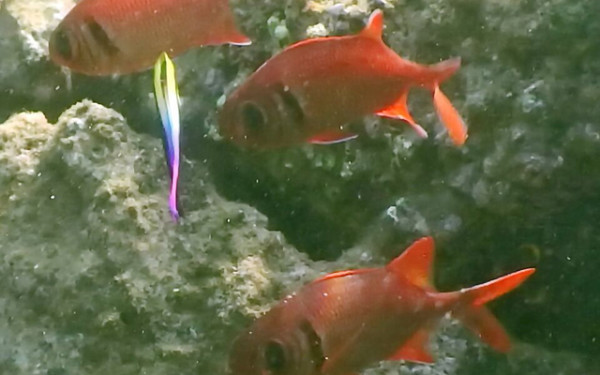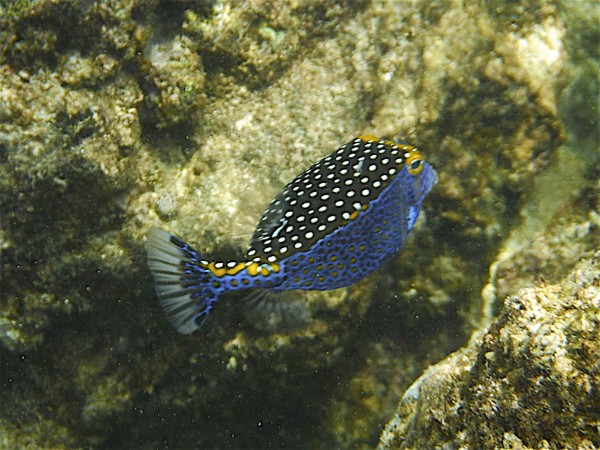Published in the Ocean Watch column, Honolulu Star-Advertiser © Susan Scott
April 11, 2016
Whenever I peek in a cave I pass during one of my favorite snorkeling routes, the Dr. Seuss book title, “One Fish, Two Fish, Red Fish, Blue Fish” starts worming through my brain. Even though I can only see flashes of scarlet in the dark little space, I know there’s at least one or two fish in there and they’re red. And that narrows the identity down to one of three red cave dwellers in Hawaii: soldierfish, squirrelfish or bigeyes.
 A blue, pink and yellow Hawaiian cleaner wrasse cleans a
A blue, pink and yellow Hawaiian cleaner wrasse cleans a
soldierfish as two others wait their turn just outside their cave.
©2016 Susan Scott
Because those fish total about 25 species here, it can be tough to pinpoint a single one. But if the skittish fish allow me a look at their bodies, I can at least pick the right clan.
A major clue is the tails. Soldierfish and squirrelfish have forked tails, the center forming a V. Bigeye tails are a solid fan shape. That leaves soldierfish versus squirrelfish. The name soldierfish is big clue. Most species have a dark bar behind each gill cover resembling epaulettes, the shoulder strips on some military uniforms. Another possibility of the origin of the name is that the solid red bodies reminded someone of the 18th century British soldiers called redcoats.

Although I didn’t hear grunts, the Hawaiian name, `u`u, may have come from the sound soldierfish sometimes make when alarmed. Today, most Hawaii anglers and markets call soldierfish by the fishes’ Japanese name, menpachi.
Squirrelfish, called `ala`ihi in Hawaiian, lack epaulettes, but have light-colored horizontal lines that run from gills to tails. One Hawaii author wonders if the name came from the fish acting squirrely, since they dash back and forth in their shelters when threatened.
Although they’re hard to see in a swimming fish, squirrelfish have needle-sharp, backwards-pointing spines, one on each gill cover. In some species, such as the longjaw squirrelfish, the spike bears a toxin that in human skin causes excruciating pain. Anglers who get poked are usually trying to remove a hook from the fish’s mouth.
All these scarlet fish rest in caves and under ledges during the day, bigeyes usually alone, the other two in schools. At night, soldierfish and bigeyes come out to hunt for tiny drifting animals. Squirrelfish search the ocean floor for crabs and shrimp. Last week during my morning swim, I passed my red-fish-blue-fish cave and got a surprise. Hanging outside the doorway, in bright sunshine, were ten red soldierfish waiting patiently for service from a busy blue, pink and yellow cleaner wrasse. My new title “One Fish, Ten Fish, Red Fish, Blue-Pink-Yellow Fish” doesn’t have much of a ring to it, but my conclusion is the same Dr. Seuss’s book: “Every day, from here to there, funny things are everywhere.”
 Bonus blue fish: Male Hawaiian Spotted Boxfish.
Bonus blue fish: Male Hawaiian Spotted Boxfish.
Susan’s web guy’s favorite blue fish.
©2014 Scott R. Davis